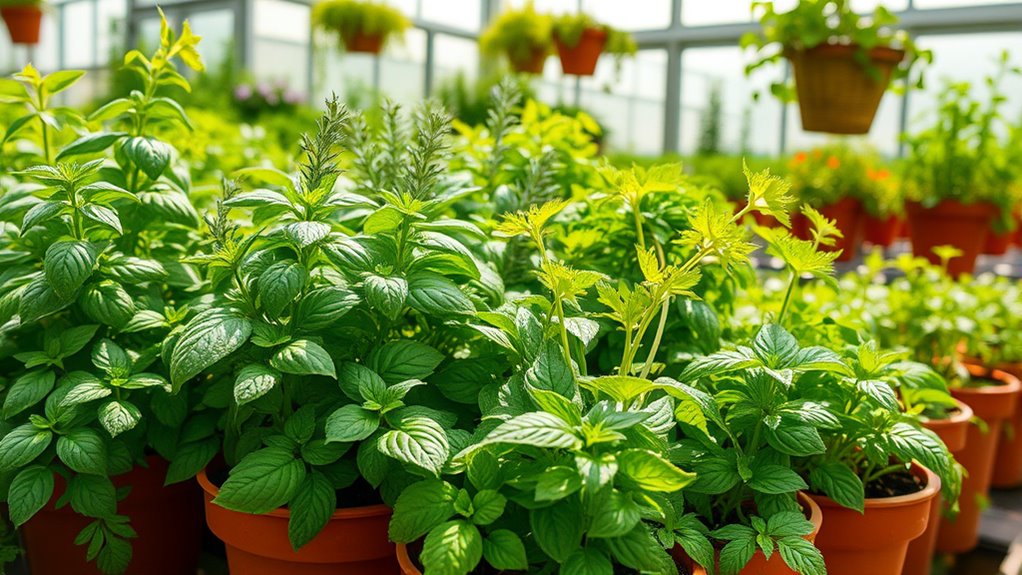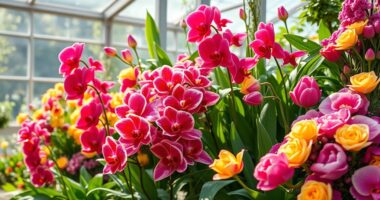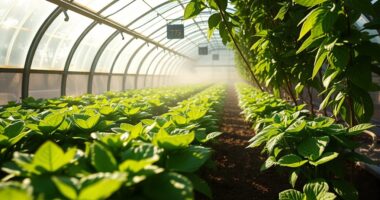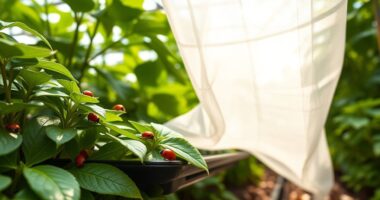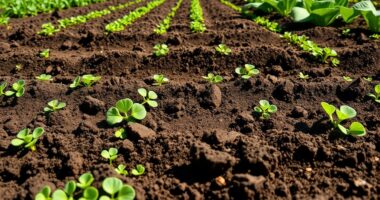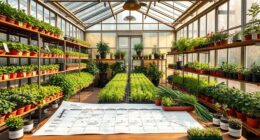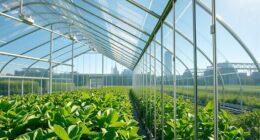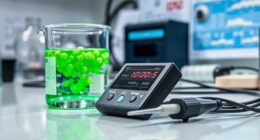Growing herbs in a greenhouse allows you to enjoy fresh, flavorful herbs all year long by controlling temperature, humidity, and light. With a controlled environment, you can prevent pests and diseases more easily, ensuring healthier plants. Hydroponic systems make efficient use of space and accelerate growth, while multiple harvests become possible throughout the year. To discover more about maximizing your greenhouse’s potential for year-round herb growing, continue exploring the options available.
Key Takeaways
- Greenhouses provide a controlled environment for year-round herb cultivation, ensuring consistent growth regardless of outside weather.
- Hydroponic systems in greenhouses accelerate growth and optimize nutrition, maximizing herb yield and quality.
- Physical barriers and integrated pest management in greenhouses prevent pest issues, reducing the need for chemical treatments.
- Environment control allows precise planning of planting and harvesting schedules for continuous fresh herb supply.
- Greenhouse cultivation minimizes weather disruptions, promotes sustainability, and enhances space efficiency for herb production.
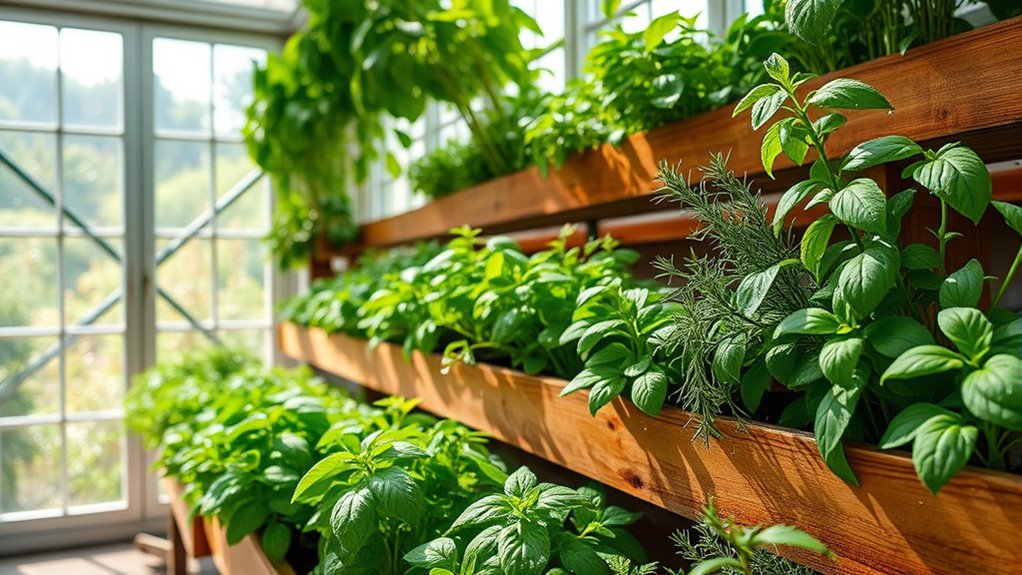
Growing herbs in a greenhouse offers you a controlled environment that promotes healthy, year-round growth. When you cultivate herbs indoors, you can regulate temperature, humidity, and light, creating ideal conditions regardless of the season outside. This consistency means you can enjoy fresh herbs whenever you need them, without worrying about seasonal shortages or weather disruptions. One effective way to maximize space and efficiency is by implementing hydroponic systems. These soilless setups allow you to grow herbs using nutrient-rich water, which promotes faster growth and better control over the plant’s nutrition. Hydroponic systems are especially useful in a greenhouse because they reduce soil-borne pests and diseases, making pest prevention easier and more effective. With fewer pests to contend with, you can focus on nurturing your herbs without the constant worry of infestations or chemical treatments.
Pest prevention is vital in maintaining healthy herb plants, and a greenhouse provides you with a physical barrier that helps keep many pests at bay. By sealing the environment, you reduce the chances of pests entering and damaging your plants. Additionally, you can implement integrated pest management strategies, such as introducing beneficial insects or using organic sprays, with less risk of affecting neighboring plants. The controlled environment also allows you to monitor plant health more closely, catching any signs of pests or disease early before they become serious problems. When combined with the cleanliness of hydroponic systems—since you’re not dealing with soil—you greatly lower the likelihood of pest and disease issues, making your herb-growing venture more sustainable. Using electric tools and equipment can further streamline maintenance and monitoring tasks within your greenhouse setup.
Growing herbs in a greenhouse also means you’re less dependent on external weather conditions, giving you the flexibility to plan your planting schedule and harvest times precisely. The environment’s stability encourages vigorous growth and yields more abundant herbs, which can be harvested multiple times throughout the year. Plus, since you’re maintaining a cleaner, more controlled space, you’re less likely to encounter weeds or invasive pests that often come with outdoor gardening. This means less time spent on pest prevention and more on enjoying fresh, flavorful herbs. Overall, combining hydroponic systems with a well-sealed greenhouse environment provides a powerful approach to growing herbs efficiently and pest-free, ensuring you have access to fresh herbs all year long.
Frequently Asked Questions
How Do I Prevent Pests in a Greenhouse Herb Garden?
To prevent pests in your greenhouse herb garden, focus on pest prevention by maintaining cleanliness and good airflow. Regularly inspect plants for signs of pests and remove affected leaves. Use natural repellents like neem oil or insecticidal soap to discourage pests without chemicals. Keeping your greenhouse healthy and balanced reduces pest problems, making your herbs thrive year-round. Consistent monitoring and natural remedies are key to keeping pests at bay effectively.
What Are the Best Lighting Conditions for Herbs Indoors?
Think of your herbs like busy bees, thriving when they get just the right sunshine. For indoor growing, make certain they receive at least 6 hours of natural sunlight daily, which is ideal. When sunlight is limited, supplement with LED grow lights to mimic natural light. This combination keeps your herbs healthy, flavorful, and lush, no matter the season, just like a garden in full bloom.
How Often Should I Water My Greenhouse Herbs?
You should water your greenhouse herbs based on their watering schedule and soil moisture levels. Check the soil regularly; it should be moist but not soggy. Typically, watering every 2-3 days works well, but this can vary with temperature and humidity. Always guarantee proper drainage to prevent root rot, and adjust your watering frequency if the soil dries out quickly or stays wet longer.
Can I Grow Herbs From Seed in a Greenhouse Year-Round?
Imagine strolling into your greenhouse, herbs sprouting from every corner. Yes, you can grow herbs from seed year-round with proper herb seed selection and careful greenhouse soil preparation. Make sure your soil is well-draining and rich in nutrients, and choose seeds suited for indoor growth. Maintain consistent warmth and light, and you’ll enjoy fresh herbs anytime, turning your greenhouse into a perpetual herb garden.
How Do I Maintain Proper Humidity Levels for Herbs?
To maintain proper humidity levels, you need effective humidity control. Use a hygrometer to monitor moisture levels regularly. If humidity drops too low, mist your herbs with a misting system or manually spray water in the air around them. Adjust misting frequency based on your readings, and guarantee good airflow to prevent mold. Consistent humidity control creates an ideal environment for your herbs to thrive year-round.
Conclusion
Now that you know how to nurture your herbs in a greenhouse, imagine your kitchen bursting with fresh, fragrant flavors all year long—like a secret garden just steps away. With a little effort, you’ll turn your space into a lush oasis where vibrant herbs thrive, transforming your cooking into a celebration of nature’s bounty. So, grab your gardening gloves and let your green thumb paint a perpetual palette of delicious possibilities. Your garden of flavor awaits!
